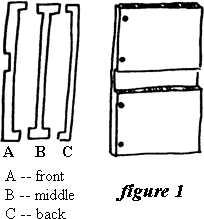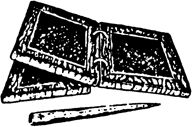Before the advent of legal pads people used a variety of things to take notes on. Roofing tiles, smooth pieces of stone or pebbles have been found with lists and inscriptions written on them. These were fine for spur of the moment things but awkward to carry around. For this the Romans used wax tablets. These were actually sheets of wood hollowed out on one or both sides to form pockets. These pockets were filled with a thin layer of wax. A sharp stylus of bone or metal was used to inscribe the information. Sometimes the writer, in a hurry or angry, inscribed right through the wax and into the wood beneath leaving. a lasting impression. The tablets were joined together with with metal rings or were laced together with leather. To erase the tablets they were exposed to heat to melt the wax, or the old wax was scraped off, re-melted, and poured back in.
You will need thin sheet or wood ½ " in thickness or less. Figure 1 shows how to hollow out the pockets. Note the slot on the cover for sealing the tablet. The easiest way to make the pockets is to use a router, but you can do it with chisels, if you wish. Drill the hole for binding, as shown. Fill the pockets not quite to the top with beeswax, or lacking that, tint some candle wax a light tan and use that instead. Bind the tablets together with metal rings or lace them together with leather (fig. 2). To send a secure message, wrap string around the tablets and seal with wax in the front recess (fig. 3).
To make a stylus cut a long sliver or bone (fig. 4) and shape it with a file (See EP issue #2, "Making Bone Needles"). Sharpen one end to a point for writing. You can attach it to your "notebook" with a thong or cord to avoid losing it.
Back to Early Period #5 |
Back to Early Period Index |
Back to PastTimes










